Notes
Were the Reuters "Boy in a Syrian Bomb Factory" Photos Staged?
Following up a post last week at the NY Times Lens Blog, Donald Winslow at the National Press Photographer’s Association (NPPA) website detailed the circumstances surrounding a photo story distributed last September by Reuters. Published after the Assad government’s gas attack in Ghouta, the images depicted the heroic story of Issa, a 10-year-old boy in Aleppo who works ten hours a day with his father in a munitions factory for the Free Syrian Army. Or so we’re led to believe.
If we can count on a few news photos a year being discredited, these allegations not only involve a whole series but a photo story — as you can see from this small sampling of screen grabs — that achieved wide circulation as well as high distinction.
Just below, you can see that the series earned distinction by both the Baltimore Sun and the New York Times through inclusion of this photo in their featured 2013 “Photos of the Year.”
If many photo news sites and blogs exist to detail the politics and the ethics of this type of story, our niche is slightly different. At BagNews, we’re primarily interested in what we can see in, and understand from the pictures themselves. For that reason, we reached out to various experts to provide us their sense of whether the photos were authentic or not, and why.
Because the photojournalism world is small and highly interdependent, most people agreed to share with us in exchange for anonymity. The result — from almost a dozen conflict photographers, photo editors and informed reporters — is a “crowdsourced” cross-section of analysis ranging from the photographic to the mechanical to the social-cultural. …To a person, I should add, everyone we spoke to was convinced the photos were staged. (Posting about the photos last September, the images struck us as odd, too.)
We hope that this post might contribute to a thoughtful, open and persistent examination — among concerned citizens, the photo community and among photo- and news media — about the truth behind this story, as well as how stories in conflict zones can be visually procured today. Below, we’ve paired photos from the story with either direct quotes or paraphrased comments from the reactions we received:
• What could the person (the father?) be doing in the far background, obscured or hidden like that?
• The arrangement of bombs … they should not be so evenly spaced. The real world is random, and anyway, they would have likely been grouped with the others as opposed to laid out as if he was doing an operation with the group of them.
• It’s one thing if he’s in there as a helper, but he seemed to be the lead guy without any adult supervision or oversight. You’re not going to see a 10-year-old wandering around these factories alone, in a completely empty space, as if he’s a solo operator, making munitions a-to-z. The whole scene is completely surreal, with a dreamlike quality.
• I’ve seen kids hanging around lot of places where fighters are but I never saw a kid hanging around a munitions shop, and I’ve been in four or five in Aleppo and the surrounding district. I’ve never seen anyone operating solo in these shops. These are collective enterprises with apportioned roles. Kids can have valid tasks as spotters or spies. Those roles are absolutely ordinary and probably as old as time. But this is technically beyond what a kid can do and, moreover, it doesn’t fit a production model. This work is fairly complex; it involves trade skills. They are making fairly crude weapons but the machines that are involved, whether involving a foundry, casting aluminum fins; or a lathe to make a mortar; or a drill press to make an opening, to cut vent holes, these are the domains of experienced machinists.
• If you know about military munitions, you know that one mistake and the block get blown to bits flattening everything for some distance. Who would put this boy in there like that?
• Where is this workshop with such clean light?
• These weapons tend to be made in auto garages or metal shops and you will see a regular shift of people there. It’s almost impossible to get a picture without other people around. They are that crowded. The idea a kid would have title or lease to the space and be there alone is a farce. They are not empty. They may be under private ownership but they are hardly ever empty. Typically, at the same time they’re producing weapons, you can also get your brakes done.
• Military munitions are very heavy. 155 millimeter shells probably weigh more than the kid. Just an unloaded shell is incredibly heavy.
• I’m not sure what he’s doing pulling against the springs on the artillery piece. The tension is most likely extraordinary. Even if he was eighty pounds of muscle.
• Say there is something stuck in the barrel of the machine. Why then, in other pictures, is he at the other end doing a completely different function?
• Unless he’s completely overhauling the machine, it just doesn’t make sense he would be performing so many different mechanical functions.
• When he’s underneath , why would he be pulling on the cross bar rather than the differential, just to the left. He doesn’t appear to be working on the differential or the brakes. There is no moving part there. There is nothing conceivable in this photo he could be doing on the machine.
• I’m not clear what they’re trying to show here but the ability to manipulate the artillery piece is far fetched. How would he have the physical power? These weigh thousands of pounds.
• It’s one thing to say he’s trained to place a fuse in a bomb. But the idea that he could work on an entire artillery piece involves a completely different level of training.
• The lighting looks staged. Is this from a camera flash? Is he supposed to be moving? If he is, it’s odd that every detail in the photo is razor sharp. if he’s moving (versus posing) with what looks like a 50-60 pound loaded rocket, we should seen some sign of it (indication of motion).
• Why is the guy in the background with his hand behind his back trying to stay out of the way? Why would he be trying to stay outside the frame? It’s a working factory, right?
• Some guys operate lathes. Some make the mortars. It’s typically done by different people. I’ve been in these shops in Aleppo. There is always a mix of machinists, painters, guys with engineering backgrounds — all doing separate tasks. It’s very rare to see anyone there who can make munitions start to finish.
• There is everything wrong with the way he’s using the lathe. The piece he’s measuring is a cone. At what point on the cone are you measuring? The measurement increases as it moves. And you don’t stand back from it like that. You’re in close, as you’re measuring to the thousandths-of-an-inch. The micrometer has to barely touch both sides of the shell. There is a gauge on the micrometer. You have to be reading the gage. He’s holding it out away from him. Nobody used a tool like that to do precise measurements.
• It looks like finger marks on his face. Like precision smudges. Usually, doing this kind of work, you’ll rub your face with the back of your hand and make smears.
• My ears were always black when I worked in places like that. His ears are clean. And that’s after spending actual time on his back rolling around on the ground?
• The Arab culture is very family oriented. They pay attention to their children. They value their children just like we do. They wouldn’t leave kids to wander unattended in such a dangerous place. It’s dehumanizing to Arab culture to pass a kid off like this. He may be making tea or on the margins or watching his brother or father, but otherwise, it makes no sense.
• It’s actually less important to me whether are not these images are literally staged than why they didn’t trigger louder alarm bells at the Reuters picture desk. Forgive me, and my comments are going to reflect my subjective biases of culture, aesthetics, and ideology, but a serious photojournalist should never be photographing children unless they are dead, dying, child soldiers, or otherwise truly at risk or victimized by circumstances beyond their control.
That sounds awfully cynical, but otherwise images of children are just too emotionally manipulative without enough cause. These images, if authentic, might fall under legitimate documentation of “child labor” if they were not so cloying — but exactly because they are so “cute”, they shouldn’t be published as news photography even if real. That’s a judgment call on my part, but it’s that kind of editorial decision making that we rely on in experienced editors, journalists, and photographers to have and use on a daily basis.
• Local stringers for international news organizations like Reuters are paid a pittance to take enormous risks. Without training or accountable supervision, it’s not surprising that some rules get broken in theater. What’s more worrying is that the much better paid editors sitting comfortably at their faraway desks can be so seemingly naive.
• I can’t understand why Reuters hasn’t been more interested in the politics of the pictures they are moving. The integrity of their whole network is at stake, a whole network of unsupervised freelancers.
• As we move more and more into consuming citizen journalism and imagery from sources that are not properly vetted, we the audience open ourselves up to the possibility of being deceived. This is why there continues to be a need for photojournalism provided by actual authors with relationships to the distribution sources. But we are not there, and … agencies such as Reuters are treating photography as a commodity that can be provided by everyone.
While I understand and acknowledge that having vetted and/or experienced photojournalists everywhere providing all the imagery is not feasible, at the same time it is up to those that distribute the work to understand, train and vouch for the work they are showing to the world. As a result I think that the world of photojournalism is close to a breaking point of trust with the public.
Update: 3/25/14 11:53 am PST: We received the following message from Reuters this morning. There is a both a general statement and a specific comment about the story above:
We have thoroughly investigated the claims made by the Times and NPPA and established to our satisfaction that the pictures were not staged. Setting up pictures is a firing offense, strictly against policy. It is the responsibility of Reuters’ chief photographers, photo desks in the region and the filing desk in Singapore to question every picture we serve to clients where a setup is suspected. Reuters will not use any photographer, freelance or staff, who is found to have passed off a set-up picture as a spontaneous one.
On the boy in the factory:
The photos of boy in the factory in Aleppo were not staged. On September 4th, photographer Hamid Khatib was working on a story about factories making munitions and weapons. Hamid visited a number of factories and at one he spotted the child Issa. Reuters thought the story of child worker Issa in a munitions factory was one that we could develop for our photography app and website Wider Image – which features Reuters images expanded into deeper, more contextual stories – so Hamid spent the day with the father and his child on September 7th.
See our follow up post with analysis on yet another set of images by the same freelancer: The Dysfunctional Guitar: More on the Reuters Syria Photo Controversy. The repeated appearance of the same damaged instrument in multiple images raises more questions about objectivity and legitimacy.
(photos: Hamid Khatib/Reuters)
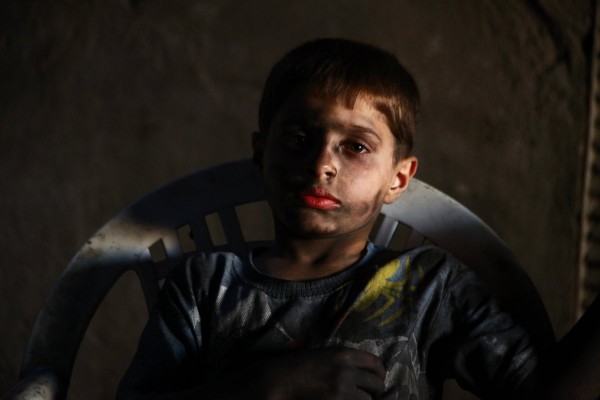
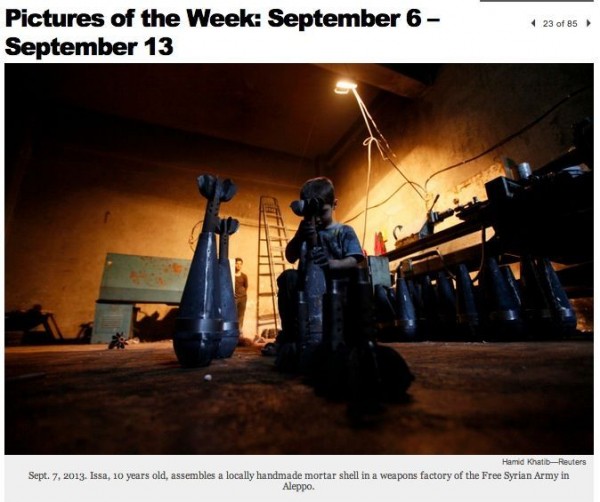
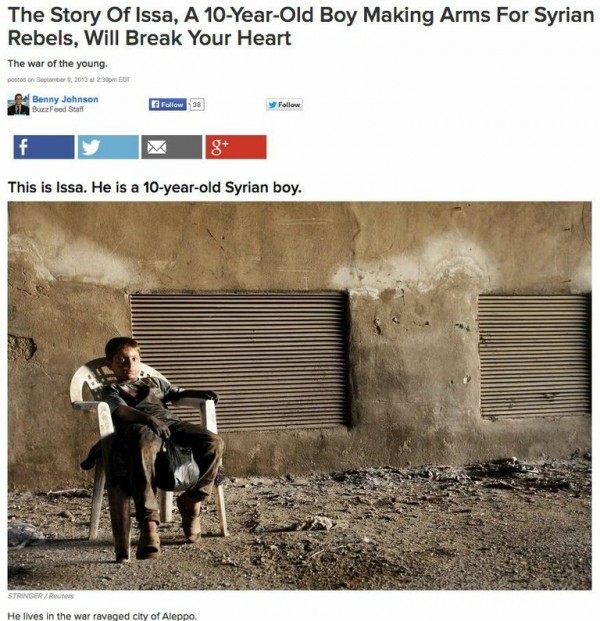
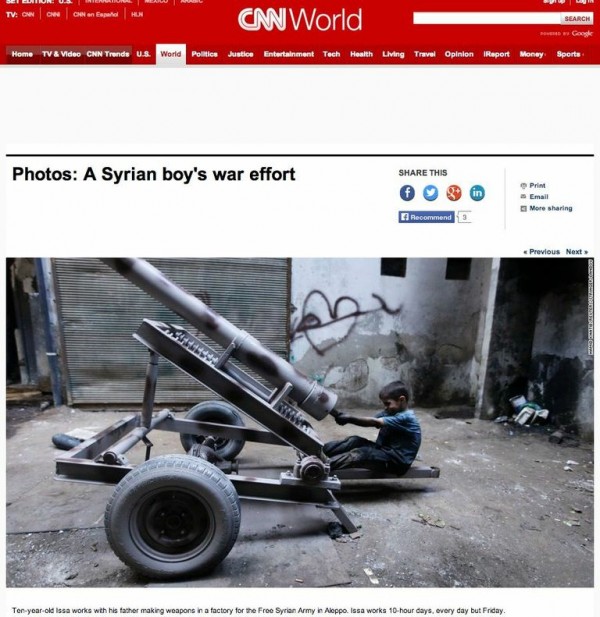
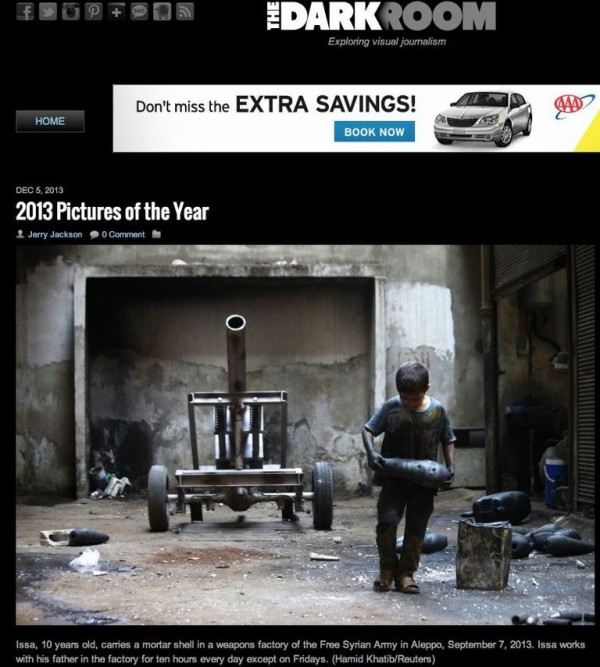
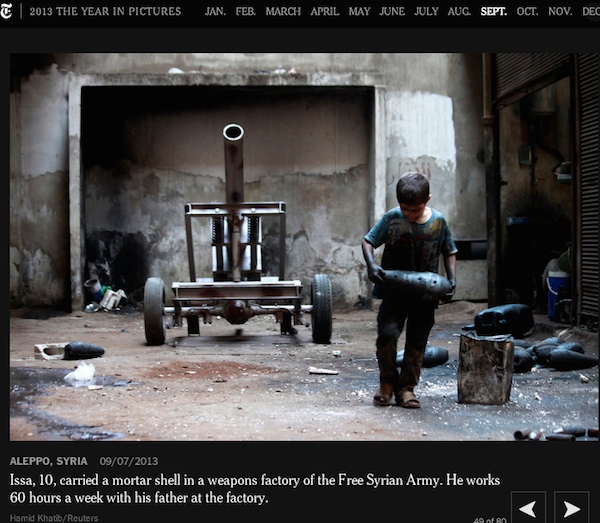




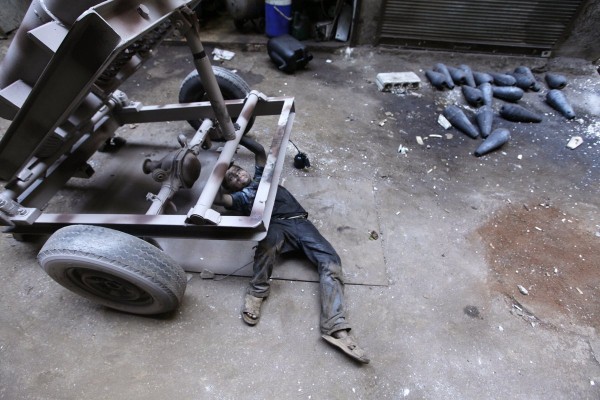



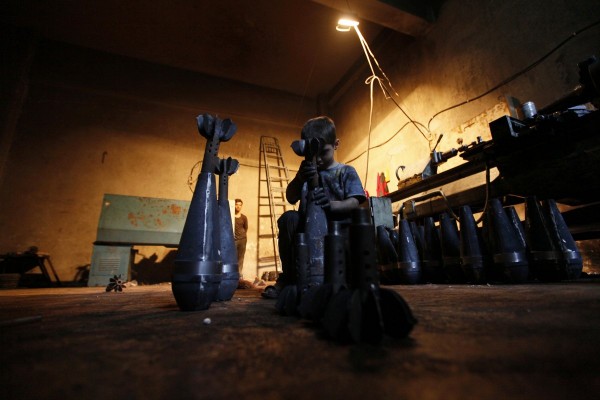

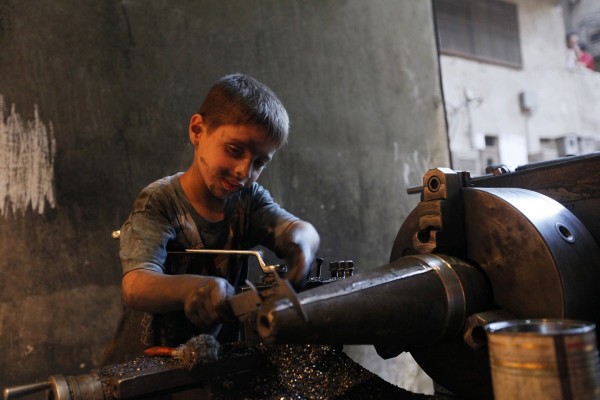



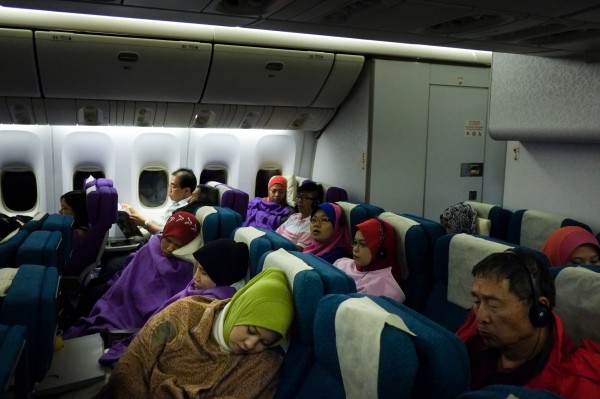
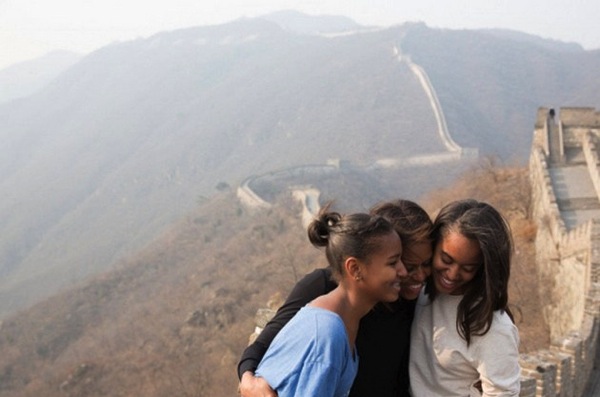
Reactions
Comments Powered by Disqus